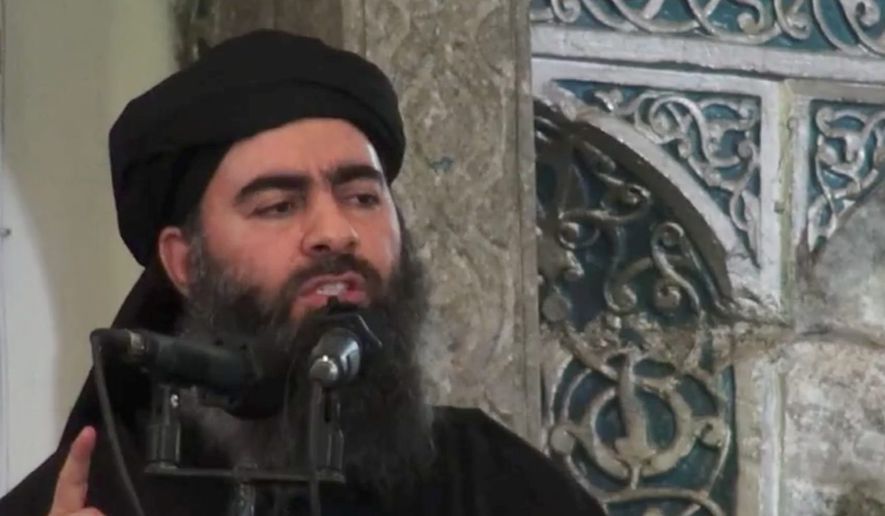The Islamic State terrorist army’s brutality and threats against America on Aug. 19 are signs it’s focusing on entrenching its so-called Muslim caliphate — without interference.
Analysts believe that Islamic State leader Abu Bakr al-Baghdadi has calculated that beheading American journalist James Foley for the world to see will work as a deterrent against the U.S. as he cements cruel Shariah law in captured cities and villages in Syria and Iraq.
“They don’t want intervention at this time from the United States, and they’re trying to deter that,” said William Braniff, director of the Study of Terrorism and Responses to Terrorism (START) at the University of Maryland. “They have something else they want to focus on, and they don’t want to be derailed. What that [means] is the Islamic State is building the institutions of the caliphate.”
On Sunday Islamic State fighters seized a key military air base in northeastern Syria, capturing the last government outpost in a province controlled by the extremist army.
The jihadis launched their long-anticipated offensive last week to seize the sprawling Tabqa air field, located some 25 miles from the extremists’ stronghold in the city of Raqqa, The Associated Press reported. The air base was one of the most significant government military facilities in the area, containing several warplane squadrons, helicopters, tanks, artillery and ammunition.
The Islamic State’s grisly video of Mr. Foley’s beheading last week, coupled with a series of social media threats to kill Americans, came after President Obama authorized a limited airstrike campaign to help Iraqi and Kurdish forces retake the Mosul Dam and protect the northern Iraqi city of Irbil.
Bart Bechtel, a former CIA officer, said the Islamic State’s day of horror starkly underlines its ultimate goal.
“It’s just confirmation of what many of us have been saying for some time,” Mr. Bechtel said. “Their determination to strike at the West — and, in particular, the U.S. — is in full display, yet there are too many whistling past the graveyard. One can certainly expect that all captives will be just as brutally killed and filmed.”
The Islamic State, which also is known by the initials ISIS and ISIL, is thought to hold as many as 20 Westerners, including one American journalist and international aid workers.
Steven Bucci, a former Pentagon official and analyst at the Heritage Foundation, said the beheading and threats have proved to be “a wake-up call” that poses risks to the Islamic State.
“I think what it tells us is, on one hand, they’re very savvy, that they understand media and propaganda and shock value and intimidation probably to a higher degree than al-Qaeda did,” he said. “You run the risk of not intimidating the other guy. You just wake up a sleeping giant. This was a very risky thing to do.”
Ken Allard, a retired Army officer and military analyst, said the Foley execution, and any subsequent attacks on America, will galvanize the world against the Islamic extremists.
PHOTOS: Top 10 U.S. fighter jets
“That beheading video seems like the one thing guaranteed to show the true nature of militant Islam, something that moderate Arabs, Egyptians, Israelis, Coptic Christians and U.S. soldiers have long understood,” he said. “If IS carries out its threats to attack the American homeland, it may even accomplish what 9/11 did not.”
Mr. Braniff said the Islamic State has settled on a strategy of violence against its immediate surroundings. Conversely, Osama bin Laden nearly always focused on selecting American targets — embassies, ships, New York and Washington.
“They’ve come into their own during and after the Arab Spring,” he said. “And I think they have a better read on the drivers of violence in the Muslim world currently than al-Qaeda senior leadership does.
“Al-Qaeda senior leadership banked on the ability of attacks against the far enemy, the United States, to be the drivers of resource mobilization. If they could successfully attack the United States, resources would flow in behind them,” Mr. Braniff said.
“The Islamic State, however, has understood that sectarian violence is currently driving resources, violent energy, money, men and weapons into the Middle East, into Iraq and Syria,” he said.
The Islamic State rose from the ashes of al-Qaeda in Iraq, the terrorist group the U.S. largely defeated before Mr. Obama pulled all troops out of the country in December 2011.
Under the leadership of al-Baghdadi, a Muslim cleric from Samara whom the U.S. tried to kill on at least four occasions, the Islamic State took advantage of the civil war in Syria to build an army of 10,000 to 15,000 fighters. Many come from the West — Great Britain in particular.
In June, after waves of car bombings throughout Iraq, it invaded from Syria, took control of Mosul and spread south in a reign of terror that included beheadings and mass executions, as well as capturing oil-rich areas.
The Islamic State now operates in and around the Syrian town of Raqqa without interference. It is largely untouched in Iraq except for sporadic American airstrikes and a few Iraqi counterpunches.
Its twin campaigns of murder and social media prompted Defense Secretary Chuck Hagel to say last week:
“ISIL is as sophisticated and well funded as any group that we have seen. They’re beyond just a terrorist group. They marry ideology, a sophistication of strategic and tactical military prowess. They are tremendously well funded.
“Oh, this is beyond anything that we’ve seen. So we must prepare for everything. And the only way you do that is you take a cold, steely, hard look at it and get ready,” Mr. Hagel said.
• Rowan Scarborough can be reached at rscarborough@washingtontimes.com.




Please read our comment policy before commenting.